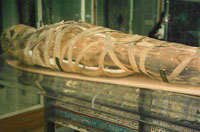Scientists Scans 2,500-year-old Mummy with a Computer
Scientists in California are using computer scans to help unwrap the mysteries of a more than 2,500-year-old mummy.

The mummy, believed to be an ancient Egyptian priest named Irethorrou, belongs to the Fine Arts Museum of San Francisco.
On Thursday, it was in a lab at Stanford University Medical School undergoing tests that could help determine what Irethorrou looked like and how he died.
The tests could also help piece together what life was like in Egypt in an era just before the Persian conquest, when the last native Egyptian dynasty ruled, The Associated Press reports.
"We basically have the mummy of someone who is a priest which is very way cool because we are able to find out how such a person himself would be buried," says Jonathan Elias from the Akhmim Mummy Studies.
21st century medical technology at Stanford University is like a time machine; the imaging equipment is able to turn back the clock 2,000 years. The power of the CT scan is that it allows researchers to view the mummy from the inside out, without ever unwrapping the dressings , informs ABC 7news.com.
The CT scan allowed scientists and mummy experts watching to immediately zoom through detailed 3-D images of the skeleton.
The mummy was on loan for 65 years to the Haggin Museum in Stockton and was recently returned to its owner, the Fine Arts Museums of San Francisco, which approached Stanford about doing a scan, said Reneé Dreyfus, curator of ancient art and interpretation.
The data collected from Thursday's scan will be the centerpiece of a new exhibition opening Oct. 31 at the Legion of Honor museum in San Francisco, reports MercuryNews.
Subscribe to Pravda.Ru Telegram channel, Facebook, RSS!





